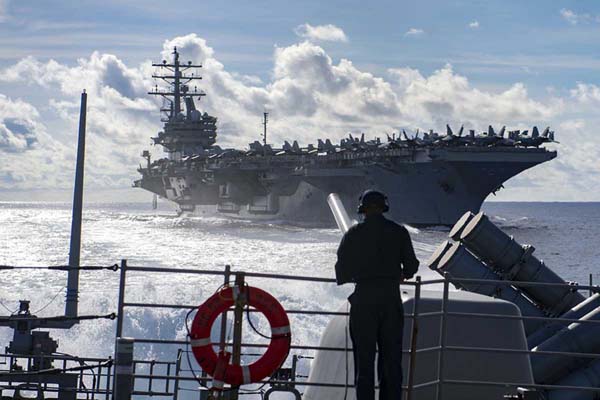
Targeting China makes US Indo-Pacific Strategy goals unachievable
Ding Gang
A year after Biden took office, the US released its much-anticipated US Indo-Pacific Strategy on February 11. It is a report drenched in poison.
The US Indo-Pacific Strategy cited Biden’s speech on Sept 24, 2021 at the first leaders’ summit of the Quadrilateral Security Dialogue (QSD) between the United States, Japan, India and Australia. He emphasized then that “the future of each of our nations — and indeed the world — depends on a free and open Indo-Pacific enduring and flourishing in the decades ahead — ahead.” This wasn’t so much a justification of the strategy, but a classic example of grandstanding by the US.
Biden is right that development in the Asia-Pacific region has a decisive impact on the future of the world. But the report deliberately avoids why the Asia-Pacific region is so important, and how the importance of this region has been built up over the past three or four decades.
Because as long as the development of the Asia-Pacific region is mentioned, it is impossible to avoid the rise of China’s driving force.
What Washington seems to forget is that the Asia-Pacific region has long since moved away from the kind of Cold War-era strategic balance that Washington has emphasized.
While we do not deny that the United States has long contributed to the stability of the Asia-Pacific, times are indeed different. Four years ago, the United Nations released the World Economic Situation and Prospects 2018, which noted that global economic growth tends to be strong, with East and South Asia remaining the most economically dynamic regions in the world, with China’s contribution to the global economy alone reaching one-third in 2017.
Asia-Pacific economies have been increasing their internal cooperation in recent years, and in particular have continued to strengthen the interconnection between industry and trade and supply chains, and have shared the dividends of China’s peaceful development. None of this has been given by the United States.
While some production networks in the Asian factories have been disrupted by the COVID-19 outbreak started in 2020, this does not shift the center of Asia’s global value chains, which are far more dependent on China than on the US, Japan and other Asian economies, says the 2021 Annual Report on Asian Economic Prospects and Integration Processes.
Among Asia’s top 22 parts and components in terms of trade volume, 18 of them are mainly relied on China. Asian factories will drive the world’s economic recovery in the aftermath of the epidemic.
It is because of China’s steady development and efforts to provide public goods via platforms such as the Belt and Road Initiative to the regional economy, thus providing a strong economic impetus to the Asia-Pacific region, that the key to the Asia-Pacific region’s continued robust development is how to further deepen its economic and trade relationship with China as the dominant force.
The US Indo-Pacific strategy aims to enlist a few countries to counterbalance China, forming a bloc as a means of containment. This would be like pulling the rug out from under one’s own feet, burying the development prospects of the region. The strengthening of the US military will certainly put the region into a very dangerous trap.
The strategy outlines five core US objectives in the region – advancing a “free and open Indo-Pacific,” building connections within and beyond the region, advancing regional prosperity, strengthening Indo-Pacific security, and building regional resilience to transnational threats.
These five goals are ambitious and enticing, but can a strategy that makes China the enemy achieve them? Ultimately, when you see China as the enemy, China will become your enemy.
When Washington targets its strategy at China and sees China as an adversary, it is poisoning the Asia-Pacific economies and planting landmines and time bombs for the peaceful development of the Asia-Pacific. The result will be that there is simply no prospect of peace, security and stable development in the Asia-Pacific region.
The writer is a senior editor with People’s Daily, and currently a senior fellow with the Chongyang Institute for Financial Studies at Renmin University of China
